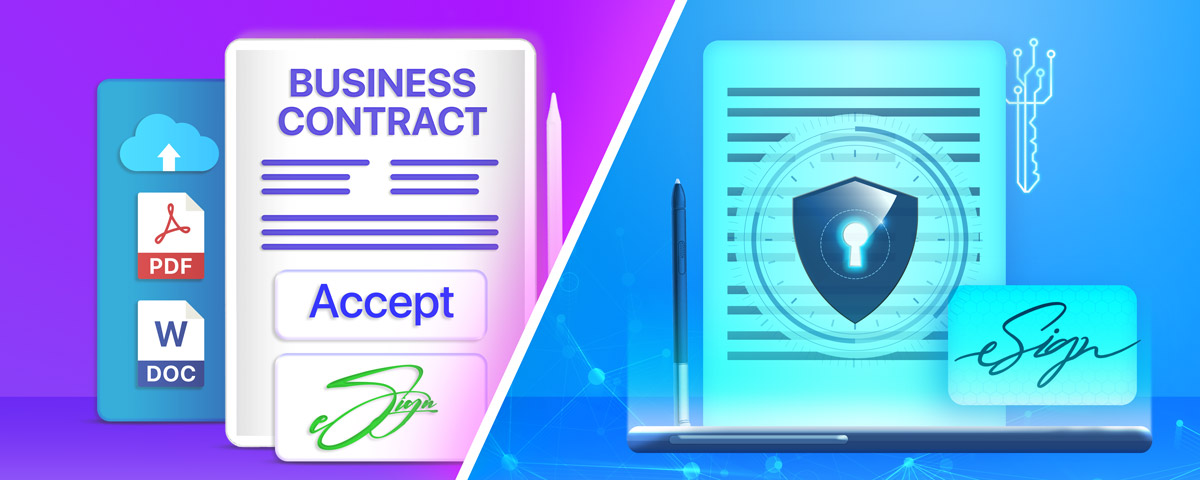The words “digital” and “electronic” in most situations can almost be used interchangeably. When it comes to signature software, there are some distinct differences, and also a lot of overlap between the two. Understanding those differences will help you to decide which solution is right for your business, and this understanding will allow you to make the most appropriate, yet cost-effective decision.
Digital signatures are a type of electronic signature, so the inclusive term for both is to call them electronic signatures, or eSignatures. The names can be a bit confusing to the layperson, and the differences between them can seem semantic at times, but there are some factors that differentiate them, and it is important to your business’s bottom line to make sure you choose the right one.
The terminology for these can be a little bit esoteric and techy at times, especially if you are not an IT or technology person. For the purpose of our discussion, we will assume you are not, and try to explain in as clear and simple terms as possible.
Wet signatures
A point of clarity—wet signatures apply to any signature that is signed traditionally, either by writing with ink or stamping, wax impression, etc. The implication of the name is it starts wet, like ink, and dries. In reality, any physically originated signature would be called a wet signature, even if it were signed in pencil or crayon (this is not recommended). Typically, this is your cursive, handwritten name. When you think of signatures, you more than likely are referring to your wet signature.
Wet signatures were long the gold standard in document approval. Your signature is unique to you, and relatively hard to fake credibly, so it works as a way to confirm the person who approved the document. Wet signatures aren’t foolproof, however.
As any teenager who has ever faked a parent’s signature knows, it is fully possible to create a passable fake of any signature you see often enough. In addition, storing all the paper needed for accurate paper record-keeping is expensive and impractical as well as creates additional labor for filing purposes.
Electronic signatures
As mentioned, electronic signature is the catch-all term for signatures that originate electronically. This would not apply to a scanned copy of a document that was printed and physically signed. That would just be a digitally-archived wet signature. Electronic signatures use software to create a secure environment where you can acknowledge and “sign” your documents.
eSigned documents can live entirely in the digital space. They are typically created either from a template or an imported PDF or word document. These digital files can be shared with signers, who then complete an electronic signature, and the document is complete.
Electronic signatures may be an actual signature captured by mouse, touchpad, touchscreen, or digital capture device, but depending on the eSigning software used and how the document is set up, they may also be completed by simply typing your full name. The software will then convert this to a generic “handwritten” font, with a memo that the signature was electronically captured.
The process for eSigning with Revv is extremely simple and straightforward. The document originator creates their document, either by uploading a PDF or word document and modifying it, or creating a document from scratch with one of our over 400 easy-to-use templates. You click the “eSign” tab and send it on to the signer. They will get an email notification that they have documents ready to sign.
You can proceed on with your day, and they can review and sign the documents at their leisure. You are able to track the document process in the software, and you will receive an email notification when the document is signed. Once the document is returned to you, it will be complete, eliminating an administrative step that slows down many offices.
Regardless of which format the particular signature uses, according to US law and court precedent, eSigned documents are as legally binding as a wet signature. This means that there is no need to print and store contracts and agreements as long as the eSigned document file is stored securely. Cloud-based servers like Revv’s keep your files safe and secure while making them accessible to any approved person who has a web browser.
Digital signature
A digital signature is a more secure version of an electronic signature. A digital signature works the same way as your electronic signature but requires both parties to have a personal and a public digital key, called a PKI, or personal key infrastructure.
The document can’t be signed without this key, making it extremely secure. An apt analogy is to think of an electronic signature like a traditional signature. It is safe and holds up in court. A digital signature is like adding a fingerprint to that wet signed document in our analogy. It adds another layer of security to prove that the document was signed by the person who was supposed to.
Digital signatures might seem like the obvious choice since they are so secure that they might be above reproach in a legal case. While it is true that security is a definite factor, an electronic signature is more than secure enough for almost all businesses. Unless you are a bank or government facility, the security elements of digital signature are overkill.
From a business owner’s perspective, too much security might feel like a good thing, but there are very good reasons to stick with the lower-security tier. First and foremost is cost. Setting up PKIs for both signers of a document will have some inherent costs associated with it. In addition, the hardware requirements will increase since simple electronic signatures can be done from almost any device with a web browser.
In addition to cost, digital signatures add to inconvenience. With an electronic signature, you could generate a contract and have it eSigned the same day. This allows new customers to call and set up accounts quickly and easily. Having to register for PKIs for every document set up, especially when it may be a one-time signature, is a very impractical way to gain new business.
One of the strategic advantages of offering eSignatures is that it allows you to quickly process new customers. When you are setting up a contract via wet signature, there is a fairly long turnaround. Documents have to be mailed, opened, read, signed, and returned, which can take weeks before you are ready to file the documents and move forward.
Even if you do tasks to expedite the process like sending the documents to the customer’s email so they can print, sign, and return, you are relying on the customer to inconvenience themselves to print and mail everything. In the meantime, your competitors are providing same-day service. The advantage of eSigning becomes obvious in this light. When your primary advantage is speed and convenience, it is impractical to add layers of complication that will slow the process back down.
Qualified electronic signature
There is a final tier of security for electronic signatures. Called qualified electronic signature, or QES, this is a more secure form of a digital signature. Where digital signature requires both parties to have a PKI and specific software, QES requires a specialized hardware device that will allow you to guarantee each party is who they are supposed to be. Returning to our analogy from earlier, if digital signing is like adding fingerprint verification to your document, QES is like adding a DNA sample.
The benefits of QES are obvious: guaranteed liability, ensured document privacy, and more. The drawbacks are just as obvious: if a digital signature adds too many layers of complication, then requiring a physical device to be utilized is clearly impractical. QES is really only needed in some banking applications and for higher security government functions. Requiring it for standard contracts is definitely overkill in almost every setting.
The takeaway
ESigning is a tool to make your business more efficient. ESigning is secure and practical for most normal business dealings, without adding additional layers of unnecessary security.
Revv makes dealing with eSigning easier. Revv uses secure cloud-based servers, so all of your electronic documents are safe at all times. Cloud storage means that your entire team can access documents whenever needed, from wherever they are. When east coast workers need contracts signed by west coast customers, Revv’s cloud-based functionality makes it convenient and efficient for both parties without requiring your customers to purchase or download any special software.
Sources:
https://www.nolo.com/legal-encyclopedia/electronic-signatures-online-contracts-29495.html
https://zegal.com/blog/post/different-types-of-electronic-signatures/
https://www.bellas-wachowski.com/is-an-e-signature-legally-enforceable.html



